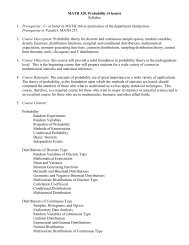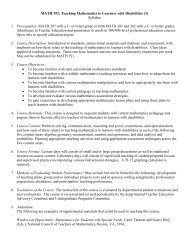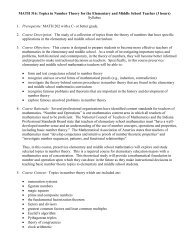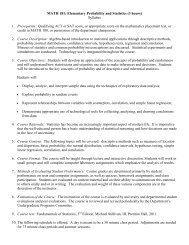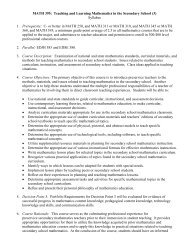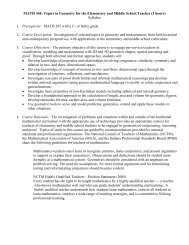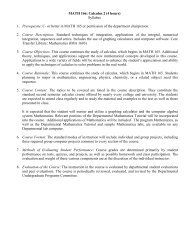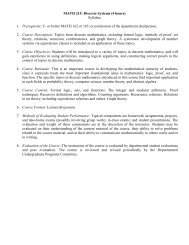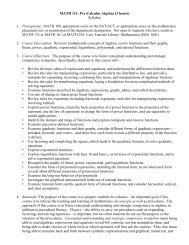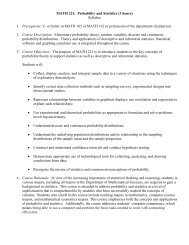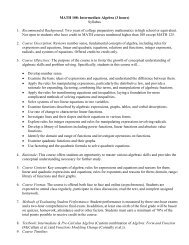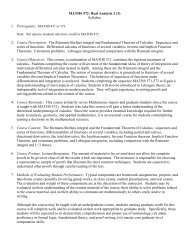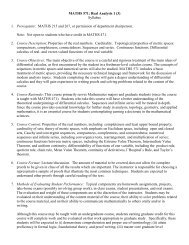MATH 202: Data Analysis, Geometry, and Measurement for the ...
MATH 202: Data Analysis, Geometry, and Measurement for the ...
MATH 202: Data Analysis, Geometry, and Measurement for the ...
- No tags were found...
You also want an ePaper? Increase the reach of your titles
YUMPU automatically turns print PDFs into web optimized ePapers that Google loves.
<strong>MATH</strong> <strong>202</strong>: <strong>Data</strong> <strong>Analysis</strong>, <strong>Geometry</strong>, <strong>and</strong> <strong>Measurement</strong> <strong>for</strong> <strong>the</strong> Elementary Teacher (3 hours)Syllabus1. Prerequisite: <strong>MATH</strong> 201 with a C– or better.2. Course Description: In-depth treatment of concepts underlying common topics in <strong>the</strong> elementaryma<strong>the</strong>matics curriculum including concepts in data analysis, geometry, <strong>and</strong> measurement. Use ofselected concrete materials <strong>and</strong> technology is included.3. Course Objectives: The course, in combination with <strong>MATH</strong> 201, is designed to provide <strong>the</strong> ma<strong>the</strong>maticsfoundation needed by teachers of elementary students. It provides an early opportunity <strong>for</strong> students toassess <strong>the</strong>ir interests, talents, <strong>and</strong> goals as prospective teachers. A fur<strong>the</strong>r objective of this course is toprovide basic academic <strong>and</strong> intellectual tools needed by effective teachers of ma<strong>the</strong>matics. Thisfoundation enables <strong>the</strong> students to communicate ideas <strong>and</strong> concepts using appropriate ma<strong>the</strong>maticallanguage.4. Course Rationale: The course is designed to provide basic academic <strong>and</strong> intellectual tools ofma<strong>the</strong>matics appropriate <strong>for</strong> prospective teachers of elementary students. The course provides acollegiate perspective of <strong>the</strong> foundations of geometry, measurement, <strong>and</strong> statistics that will help <strong>the</strong>sestudents to become effective teachers of ma<strong>the</strong>matics. St<strong>and</strong>ards <strong>and</strong> recommendations <strong>for</strong> <strong>the</strong>ma<strong>the</strong>matical content knowledge essential <strong>for</strong> preservice teachers made by <strong>the</strong> National Council ofTeachers of Ma<strong>the</strong>matics, <strong>the</strong> Ma<strong>the</strong>matical Association of America, <strong>and</strong> <strong>the</strong> Indiana ProfessionalSt<strong>and</strong>ards Board guide <strong>the</strong> selection of topics presented in this course. As a result of successfullycompleting <strong>the</strong> study of ma<strong>the</strong>matical content in <strong>MATH</strong> 201 <strong>and</strong> <strong>202</strong>/203, <strong>the</strong>se teaching majors areprepared to continue <strong>the</strong>ir educational studies in a ma<strong>the</strong>matics methods course, where <strong>the</strong>y learn how toteach <strong>the</strong>se ma<strong>the</strong>matical topics to children.Problem-solving approaches are used throughout <strong>the</strong> course to study ma<strong>the</strong>matical concepts <strong>and</strong>procedures. Through <strong>the</strong> use of various group <strong>for</strong>mats, students learn to work in concert with o<strong>the</strong>rs tosolve problems <strong>and</strong> to communicate ma<strong>the</strong>matics both verbally <strong>and</strong> in writing. Students learn techniques<strong>for</strong> logical reasoning to enhance <strong>the</strong>ir ability to engage in life-long learning. Historical, cultural, <strong>and</strong>ma<strong>the</strong>matical connections permeate <strong>the</strong> course content.The course is designed to prepare students to become effective teachers of ma<strong>the</strong>matics. Students willgain an appreciation <strong>for</strong> ma<strong>the</strong>matics <strong>and</strong> add to <strong>the</strong>ir procedural underst<strong>and</strong>ing by gaining conceptualunderst<strong>and</strong>ing through <strong>the</strong> use of selected models, materials <strong>and</strong> problem solving situations. Thesecomponents are critical to <strong>the</strong> university foundational goals of <strong>the</strong> University Core Curriculum.5. Course Content:Statistics (2-3 weeks)Measures of Central Tendency• Investigate <strong>the</strong> measures of central tendency including mean, median, <strong>and</strong> mode, <strong>and</strong> explore <strong>the</strong>relationships among <strong>the</strong>m.Measures of Variation• Investigate <strong>the</strong> measures of variation including range, variation, st<strong>and</strong>ard deviation, <strong>and</strong> outliers,<strong>and</strong> explore <strong>the</strong> relationships among <strong>the</strong>m.Graphical Representations• Construct <strong>and</strong> interpret graphical representations of data including line plots, picture graphs, bargraphs, circle graphs, stem-<strong>and</strong>-leaf plots, box-<strong>and</strong>-whisker plots, <strong>and</strong> scatter plots.
<strong>Geometry</strong> (7-8 weeks)Basic Terms• Develop geometric language <strong>and</strong> use basic geometric terms to appropriately communicatema<strong>the</strong>matical ideas.• Include language of an in<strong>for</strong>mal deductive nature (all, some, none, if-<strong>the</strong>n, what if).Plane Figures• Measure angles <strong>and</strong> explore relationships between sets of angles.• Classify quadrilaterals using minimum characteristics <strong>and</strong> develop logical arguments about <strong>the</strong>properties.• Classify triangles according to <strong>the</strong>ir sides <strong>and</strong> to <strong>the</strong>ir angles.• Investigate <strong>the</strong> interior, exterior, <strong>and</strong> central angles of regular polygons. Look <strong>for</strong> generalizations.• Use physical models to explore regular <strong>and</strong> semi-regular tessellations, <strong>and</strong> determine whichregular polygons will tessellate.• Use physical <strong>and</strong> visual models to explore reflection <strong>and</strong> rotation symmetry of plane figures.• Construct plane figures using geometric tools (protractor, compass, mira, LOGO).• Use physical <strong>and</strong> visual models to explore congruence <strong>and</strong> similarity.• Formulate <strong>and</strong> solve problems whose solutions require two-dimensional spatial sense.• Use physical <strong>and</strong> visual models to investigate trans<strong>for</strong>mations (slides, flips, <strong>and</strong> turns).Space Figures• Explore properties of prisms, pyramids, o<strong>the</strong>r polyhedra, cylinders, cones, <strong>and</strong> spheres.• Analyze <strong>and</strong> describe regular polyhedra. Look <strong>for</strong> generalizations• Explore reflection <strong>and</strong> rotation symmetry of space figures.• Formulate <strong>and</strong> solve problems whose solutions require three-dimensional spatial sense.<strong>Measurement</strong> (4-5 weeks)Nonst<strong>and</strong>ard <strong>and</strong> St<strong>and</strong>ard Units of Length, Area, <strong>and</strong> Volume• Develop ideas that units to record measure are different from <strong>the</strong> process of measurement itself.• Use st<strong>and</strong>ard <strong>and</strong> nonst<strong>and</strong>ard units to estimate <strong>and</strong> measure various attributes.Customary <strong>and</strong> Metric Units• Present measurement through its historical development.• Provide a variety of experiences with <strong>the</strong> customary <strong>and</strong> metric systems.Area <strong>and</strong> Perimeter: rectangles, squares, parallelograms, triangles, trapezoids, circles, irregular polygons• Develop <strong>the</strong> <strong>for</strong>mulas <strong>for</strong> area <strong>and</strong> perimeter through meaningful activities.• Investigate relationships between area <strong>and</strong> perimeter.• Formulate <strong>and</strong> solve problems whose solutions require two-dimensional spatial sense.Volume <strong>and</strong> Surface Area: polyhedra, prisms, pyramids, spheres, cones• Develop <strong>the</strong> <strong>for</strong>mulas <strong>for</strong> volume <strong>and</strong> surface area through meaningful activities.• Investigate relationships between volume <strong>and</strong> surface area.• Formulate <strong>and</strong> solve problems whose solutions require three-dimensional spatial sense.Pythagorean Theorem• Discover, generalize, <strong>and</strong> communicate conjectures which support <strong>the</strong> Pythagorean Theoremthrough <strong>the</strong> use of area models.• Formulate <strong>and</strong> solve problems whose solutions require <strong>the</strong> Pythagorean Theorem.6. Course Format: Students work individually <strong>and</strong> in small groups to solve problems <strong>and</strong> participate inactivities in class <strong>and</strong> to complete assignments outside of class. Faculty engages students in interactive
lectures <strong>and</strong> whole-class discussions. Students use calculators <strong>and</strong> computers to solve problems <strong>and</strong>explore various representations of ma<strong>the</strong>matical concepts. A TI-73 graphing calculator is required.Geometer’s Sketchpad is required.7. Methods <strong>for</strong> Evaluating Student Per<strong>for</strong>mance: Methods used <strong>for</strong> evaluating student per<strong>for</strong>mance mayinclude but are not limited to <strong>the</strong> following: exams, quizzes, homework assignments, essays, journals,<strong>and</strong> projects. The evaluation <strong>and</strong> weight of <strong>the</strong>se various components are at <strong>the</strong> discretion of <strong>the</strong>individual instructor.Additionally, a set of common assessment instruments will be used in all sections of <strong>MATH</strong> <strong>202</strong>. Thesewill include <strong>the</strong> following: a gateway exam, individual problem-solving assignments, collaborativeprojects, <strong>and</strong> a set of common final exam questions.8. Evaluation of <strong>the</strong> Course: The departmental Teacher Education Advisory Committee <strong>and</strong>Undergraduate Programs Committee periodically evaluate <strong>the</strong>se courses. The instruction of <strong>the</strong> course isevaluated by departmental student evaluations <strong>and</strong> peer evaluations.[1/01, Stump; 12/02, E. Bremigan; 4/07, S. Kerlin; 11/10, Pierce; March 2013, UPC, Chair Pierce; Fall 2014,UPC, R. Pierce Chair]



